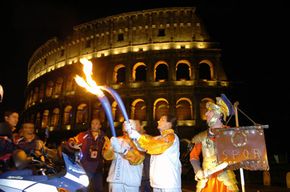The Torch Relay
The Olympic Torch Relay begins with the torch lighting in Olympia, Greece. From there, the journey to the host city varies from year to year. The Olympic Games Organizing Committee (OCOG) determines the route, as well as the theme, modes of transportation for the torch, and the stops that it will take along its way to the Opening Ceremony.
The torch is generally carried from one country to another on a plane. Once it arrives in a city, it usually spends one day being carried from torchbearer to torchbearer on foot. It may also be ferried from place to place by car, boat, bicycle, motorcycle, dog sled, horse, or virtually any other type of conveyance.
Advertisement
On certain legs of the relay, the torch must be housed in a special container. For a trip across the Great Barrier Reef before the 2000 Olympic Games, a special torch was designed to burn underwater. On airplanes, where open flames are not allowed, the flame is typically stored in an enclosed lamp, much like a Miner's lamp. At night, it is kept in a special cauldron until the relay begins once again the following day.
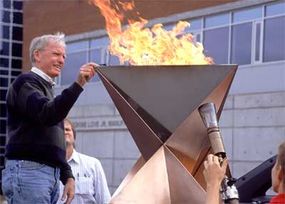
As in any relay race, each runner carries the torch for only one short leg of its trip As a runner completes a leg, he lights the torch of the next person in the relay.
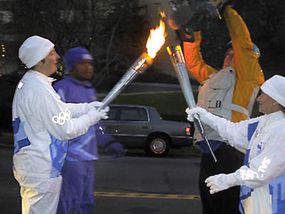
It is considered a great privilege to be chosen as a torchbearer. Athletes, actors, musicians, sports figures, and politicians have all carried the flame. In 1996, boxing legend Muhammed Ali lit the Olympic cauldron to mark the start of the Games in Atlanta. But the brunt of the running is done by average citizens all around the world.

Almost anyone can carry a torch, provided that he is at least 14 years old and is able to carry it for at least 400 meters (437 yards). Handicapped people can be (and have been) torchbearers -- they can carry the torch while riding in a wheelchair. The torchbearers are chosen by the Olympic sponsors and organizers, usually because they have made a significant contribution to their community and because they personify the theme of that particular Olympics. The Olympic sponsors (for example, Coca-Cola) also get to choose several torchbearers from within their organizations.
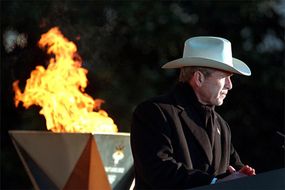
Each torchbearer is accompanied by a caravan with security personnel, a medical team, the media, and extra torches in case the torch the runner is carrying goes out.
At the end of the relay, the last torchbearer enters the Olympic stadium in the host city. The identity of that torchbearer is usually kept secret until the last moment. The final torchbearer is usually an Olympic athlete, sports figure, or an individual who has made a very special contribution to society. That individual runs around the stadium track once, then lights the Olympic cauldron, signaling the official start of the Olympic games.
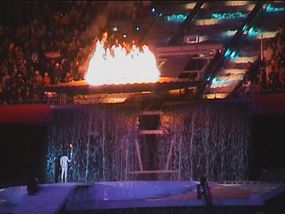
When the competition ends about two weeks later, the flame is extinguished at the Closing Ceremony, marking the end of the Games.
To find out more about the Olympics, the torch, and related topics, check out the links below.
Related HowStuffWorks Articles
More Great Links
Books
- [url='https://www.amazon.com/gp/product/158000105X/ref=as_li_qf_asin_il_tl?ie=UTF8&tag=howstuffwo029-20&creative=9325&linkCode=as2&creativeASIN=158000105X&linkId=a1ce9a7cf6ff561150f27a4b6eff0d48}Journey of the Olympic Flame[/url'], by Gayle Petty
- The Naked Olympics: The True Story of the Ancient Games, by Tony Perrottet
- The Olympic Glow, by Barbara Birenbaum and Pat Sapp
- Olympic Spirit: 100 Years of the Games by Susan Wells
- Share the Flame: The Official Retrospective of the Olympic Torch Relay by Alan Hobson and Elaine Jones
Sources
- Athens 2004 Official Web site
- Athens 2004 Olympic Torch Relay
- Birenbaum, Barbara, The Olympic Glow. Clearwater, Florida: PEARTREE, 1994.
- Dr. Gus Nathan, University of Adelaide, e-mail interview with author, July 15, 2004.
- Herzog, Brad. "Strange but True Olympic Torch Tales: Getting the Olympic Torch from Olympia, Greece, to the Games - and Lighting the Olympic Flame - can be a Real Adventure!" Sports Illustrated for Kids, October 1, 2000, pg. 22.
- Lovgren, Stefan. "En Route to Greece, Olympic Torch Touches Many," National Geographic News, July 8, 2004.
- McCormick, David. "Designing a Bright, Clean and Resilient Olympic Torch," EXN.ca, June 23, 2000.
- "The Olympic Flame and Torch Relay," Olympic Museum and Studies Center, Lausanne, 2002.
- Tilbrook, Melanie. "Olympic Torch Technology," ABC Online.
- Rostock, Roseanne. "High-Tech Olympics," Science World, May 3, 1996, pp. 6-10.
- Ruffenach, Glenn. "Getting the Olympic Flame to Atlanta Won't be a Simple Cross-Country Run," The Wall Street Journal, February 29, 1996, pg. B1 (2 pgs.)
- "The Torch Lights the Way," Wood & Wood Products, March 1996, pg. 56-57.
- Turbulence, Energy & Combustion Group (TEC), University of Adelaide.
